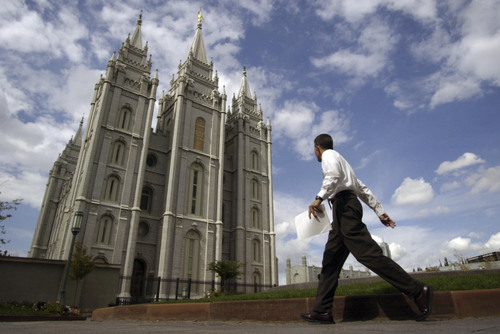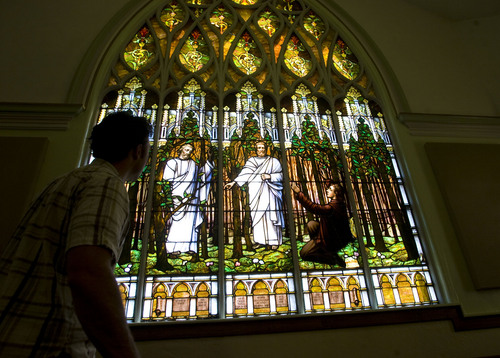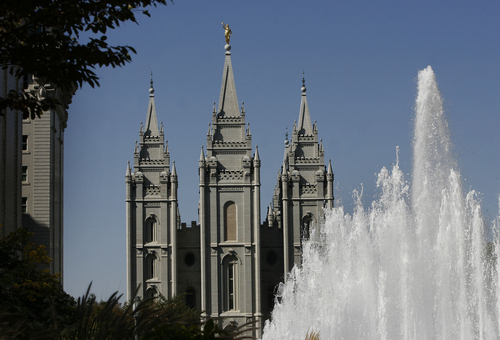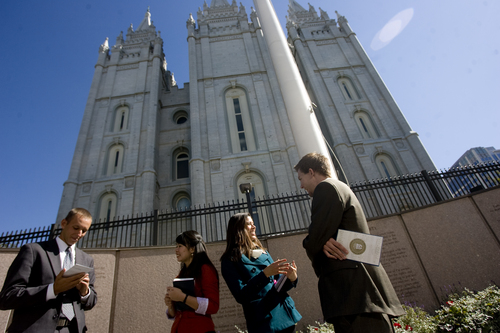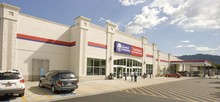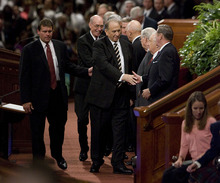This is an archived article that was published on sltrib.com in 2013, and information in the article may be outdated. It is provided only for personal research purposes and may not be reprinted.
Aaronic • Think 12-year-old boys in white shirts and ties passing communion (sacrament, in Mormon-speak) to LDS congregations every Sunday. Think 14-year-old boys, dressed much the same, preparing the bread and water for that ordinance. And think 16-year-old boys, similarly decked out, offering set blessings of the sacrament. These deacons, teachers and priests, ages 12 to 18, belong to the Aaronic Priesthood, a proving ground of sorts for young Mormon males before they go on missions (at least many of them) and receive more responsibilities in the faith's higher Melchizedek Priesthood.
Bible• Yes, Mormons have their signature scripture, the Book of Mormon, which they believe is a translated work from gold plates regarding God's dealings with ancient inhabitants in the Western Hemisphere. And, yes, they have two other canonized books, the Doctrine and Covenants and the Pearl of Great Price. But they also read, revere and believe the Bible — both the Old and New Testaments — as scripture. They use the King James Version and, as an LDS tenet teaches, "believe the Bible to be the word of God as far as it is translated correctly."
Celestial Kingdom • When Mormons speak of heaven, they usually mean the Celestial Kingdom. It is the highest of three "degrees of glory" in the hereafter, above the Terrestrial and Telestial kingdoms. Within the Celestial sphere are three levels, the top being reserved for those who are wedded or "sealed" to an eternal spouse. That's why Mormon couples marry in temples, so they can receive this sealing and qualify, if they live righteously, for the highest heaven. So, for Latter-day Saints, marriages aren't so much matches made in heaven, but rather matches made for heaven. Worthy members who are single and never have the chance to marry in mortality are promised that the opportunity will come to them after death.
Deseret• There's Deseret Industries (a Mormon-owned thrift store). There's the Deseret News (a Mormon-owned newspaper). There's Deseret Book (a Mormon-owned bookstore chain and publishing house). There also are dozens of other Deseret-dubbed businesses. But what does the word mean? Well, its roots date back to the Book of Mormon, in which the word is defined as "honeybee." The beehive, representing work and industry, is found on Utah's state flag and seal. Mormon leaders originally sought admission to the union as the State of Deseret. LDS pioneer-prophet Brigham Young even envisioned a Deseret Alphabet, with 38 characters. If it had taken hold, this list might read much differently.
Endowment• Mormons go to temples to take part in "endowment" ordinances for themselves and for people who have died. The symbolic ceremony includes ritual re-enactments of the creation, Adam and Eve's expulsion from the Garden of Eden and humankind's mortal journey and ultimate return to God's presence. In the Salt Lake and Manti temples, live actors portray these scenes. But in all other Mormon temples, the story is told through film (a new one debuted this past summer). During the ceremony, LDS temple-goers make promises to the Almighty to act, speak and think according to heaven's commands.
First Presidency• The governing body in worldwide Mormonism. It consists of the church's president (the faith's longest-tenured apostle) and, usually, two counselors (although more can serve and have served). Today, the Big Trio consists of church President Thomas S. Monson along with a first counselor, Henry B. Eyring, and a second counselor, Dieter F. Uchtdorf. All three are referred to as presidents as is the head of the Quorum of the Twelve Apostles. Right now, that's Boyd K. Packer.
Godhead• Mormons see themselves as Christians, but that doesn't mean they heed all traditional Christian beliefs. As the church's name implies, Jesus Christ is the center of Mormon devotion. He is their King of Kings and Lord of Lords. He is seen as the Son of God, the Savior of all humanity. But LDS theology differs from historic Christianity. Most Christians preach a Trinity in which God, Jesus and the Holy Spirit are one substance. Mormons believe God the Father and his son, Jesus Christ, are separate beings with glorified bodies. The third member of the LDS godhead, the Holy Ghost, is a spirit.
Home teaching• It's hard to live in Utah and not hear Mormon neighbors mention, at some point, home teaching. "Did you do your home teaching this month?" "It's the 30th, we better get out and do our home teaching." "One of my home teaching families needs help moving a piano." What is home teaching? Members of the faith's lay all-male priesthood are assigned to visit households in their congregation every month to attend to the spiritual and physical needs of these families and individuals. That's the "home" part of the phrase. These priesthood holders — who go two by two, Mormon missionary-style — often "teach" a brief religious message as well during their visits.
Infant baptism• In short, Mormons don't perform them. The earliest age at which children can be baptized into the faith is 8. Latter-day Saints do, however, bless babies, and those little ones are counted as members.
Joseph• As in Smith. Mormonism's founder had a common name but lived an uncommon life. Latter-day Saints believe his path to prophet began at age 14, when a young Joseph, confused about the competing doctrines of the day, prayed to know which church to join. Mormons teach that God and Jesus then appeared to him — in what is referred to as the First Vision — and told the boy to align with no religion and that the true gospel taught by Christ would be "restored" to the Earth through him. For the next 24 years, Smith reported numerous revelations — establishing a church, founding cities, expanding and expounding scriptures, even running for president — before his murder at the hands of a mob in Illinois in 1844. Today, his worldwide followers number nearly 15 million.
Kirtland• For much of the 1830s, this northeastern Ohio town near the banks of Lake Erie, was the principal headquarters of the LDS Church. It is here that Mormons erected their first temple. Today, that edifice is a national historic landmark and is owned by the Community of Christ, the chief offshoot of the Utah-based Church of Jesus Christ of Latter-day Saints.
Liahona• In the Book of Mormon, this compass helped a principal prophet and his family find their way in the wilderness. This instrument worked according to the faith and faithfulness of its holders. In LDS lore, it rested with the gold plates — from which Joseph Smith is said to have translated the Book of Mormon. The plates and Lehi's Liahona, according to church history, were returned to Angel Moroni, the last prophet in the Book of Mormon. Today, the church publishes an international magazine called the Liahona.
Missionaries• Surely you've seen them. They travel two by two — the younger-than-ever men in white shirts and ties and the younger-than-ever women in dresses or skirts — with scriptures in hand, planners in pockets and high hopes in their hearts. They walk, bike, bus and drive. They wake at 6:30 a.m. and go to sleep at 10:30 p.m. In between, there are hours of studying, prayer and proselytizing. They get no salary. In fact, they (and/or their families) usually pay about $400 a month. Full-time Mormon missionaries number 75,000, serving in 405 missions around the world. That's up nearly 30 percent since last October, when LDS leaders lowered the minimum age to 18 (down from 19) for men and 19 (down from 21) for women. The men go out for two years; the women for 18 months. Retired couples also don missionary name badges and serve for varying lengths of time.
Nauvoo• This western Illinois city on the banks of the Mississippi River blossomed into the LDS Church's headquarters from 1839 to 1846. There, the Mormons built a fast-growing community that almost rivaled Chicago. There, they established a militia with Joseph Smith as commander. There, they built their second temple, before abandoning it for the trek to Utah. (It was torched in 1848 and rebuilt in 2002.) And there, they buried their beloved prophet, Joseph, and his brother, Hyrum, after they were murdered in nearby Carthage.
Oil• Mormon men ordained to the Melchizedek Priesthood use olive oil, which they have consecrated with a special prayer, to bless the sick. They often carry small vials of this oil in their pockets or on their key chains.
Polygamy• At one time, polygamy played a central role in Mormonism. Now, any members participating in it are excommunicated. The Utah-based faith officially swore off plural marriage in 1890, when then-President Wilford Woodruff issued his "Manifesto." Some splinter groups still practice polygamy. And even mainstream Mormon scriptures describe and defend it. In fact, Mormon men can be "sealed," or married for eternity, in temples to multiple women, but a woman can be sealed to only one man.
Quorum of the Twelve Apostles • Together, these men, each one ordained as "prophets, seers and revelators," rank as the second-highest governing body (after the First Presidency) in the LDS Church. Members of the Twelve serve for life and are seen as "special witnesses" of Christ. When a Mormon president dies, the governing First Presidency is dissolved and the longest-tenured apostle becomes the global church's next leader.
Relief Society• All adult women in the LDS Church belong to this organization, which Joseph Smith began 171 years ago. Each Mormon ward, or congregation, has a Relief Society, which provides, among other offerings, compassionate service to members such as meals to the grieving, homebound and heartbroken. Each ward also has a Relief Society president and she, in turn, has two female counselors. Same goes for LDS stakes, which oversee clusters of congregations. Churchwide, the general Relief Society president is Linda K. Burton. Her counselors are Carole M. Stephens and Linda S. Reeves.
Saints• No St. Peter. No St. Francis. No St. Catherine. You won't find any patron saints in LDS theology. But you'll find plenty of saints in Mormonism. In fact, every member is seen as one — thus the name Latter-day Saint. It is a title earned not through saintly deeds, but rather through a singular act: joining the LDS Church.
Tithing• Devout Mormons donate a tenth of their income to the church as tithing. This money helps pay for the chapels, temples, universities, welfare operations and more. The faith's ruling councils — the First Presidency, Quorum of the Twelve Apostles and Presiding Bishopric — oversee how the funds are spent. How much money are we talking about? That information is not publicly available. However, an investigation by Reuters and a University of Tampa sociologist, reported in a Businessweek article last year, estimated that the LDS Church amasses up to $8 billion a year in tithing.
Urim and Thummim• Huh? These instruments are mentioned in Hebrew and Mormon scriptures. Latter-day Saints believe Joseph Smith, following in the footsteps of ancient prophets, used the Urim and Thummim to translate much of the Book of Mormon. At one point, the LDS founder described them as "two transparent stones set in the rim of a bow fastened to a breastplate."
Virgin birth• Like many Christians, Mormons believe that Jesus' mother, Mary, was a virgin when he was born. Unlike Catholics, though, Latter-day Saints teach that Mary was not a perpetual virgin. They believe she later had children by her earthly husband, Joseph.
Word of Wisdom • Good Mormons don't drink and don't smoke. They don't consume coffee or tea either. Perhaps no other LDS teaching can so visibly "out" Latter-day Saints. At cocktail parties, they're downing Sprite. At restaurants, they do the "Mormon flip," turning over their coffee cups. These behaviors are rooted in the Word of Wisdom, the faith's health code. Issued by Joseph Smith in 1833, it teaches Mormons to eschew alcohol, tobacco and "hot drinks," which church leaders subsequently described as "coffee and tea." Many members presume the ban on coffee and tea is because both beverages contain caffeine, so they avoid, say, Mountain Dew or Pepsi or Coke. But LDS leaders have reaffirmed their longtime stance that the only prohibited drinks are alcohol, coffee and tea. So caffeinated colas are kosher.
Young• As in Brigham. He is called the Mormon Moses because he led the exodus of Latter-day Saints from Illinois to a promised land: the Salt Lake Valley. He became the faith's second president after Joseph Smith's murder. In Utah, he rose to territorial governor and colonized much of the West — establishing settlements stretching from San Bernardino to Las Vegas to Logan and points in between and beyond. He died in 1877 at age 76 after leading the church for nearly 30 years as president, the longest tenure of any Mormon prophet.
Zion • For Mormons, Zion can be a particular place where the saints live. At various times in LDS history, for instance, Zion has been Kirtland, Ohio; Jackson County, Mo.; Nauvoo, Ill.; and Salt Lake City. Zion also can be any place where the saints live — from Tokyo to Tooele, Albania to Zimbabwe. And Zion can be an attitudinal place because Mormon scripture describes it as the "pure in heart."
Sources: Encyclopedia of Mormonism, lds.org, Salt Lake Tribune archives



